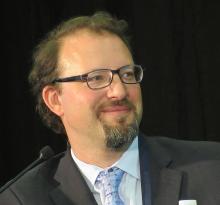MADRID – Cerdulatinib, a single oral agent targeting two different pathways that lymphomas rely on for survival, produced rapid tumor responses in patients with relapsed or refractory non-Hodgkin lymphomas (NHL) in a phase II study.
The overall response rate among 47 patients enrolled in a phase II study was 50%, including responses among 67% of patients with chronic lymphocytic leukemia/small lymphocytic lymphoma (CLL/SLL) and 56% of patients with follicular lymphoma (FL), reported Paul A. Hamlin, MD, of the Memorial Sloan Kettering Cancer Center in New York.
Cerdulatinib is an orally dosed agent that inhibits both the Janus kinase (JAK) 1 and 3 pathways and the spleen tyrosine kinase (SYK) pathway.“At a dose of 30 mg b.i.d., cerdulatinib inhibited pathways of interest, so both SYK and JAK are inhibited at maximum amounts at physiologically attained doses,” he said at a briefing at the annual congress of the European Hematology Association.
Certain B cell malignancies are “addicted” to B cell antigen-receptor (BCR) signaling. A combination of selective SYK and JAK inhibitors can syngergistically suppress this response in B cell malignancies, he said.
In a phase I dose escalation study of cerdulatinib in 43 patients with relapsed/refractory CLL and NHL reported by Dr. Hamlin and his colleagues at the 2016 EHA annual congress, inhibition with cerdulatinib of both the BCR/SYK and JAK/STAT pathways in peripheral blood assays was well tolerated.
In the current phase II, multicenter, open-label study, the investigators plan on enrolling up to 40 patients in each of three cohorts: relapsed refractory CLL/SLL, relapsed/refractory indolent NHL, and relapsed diffuse large B cell lymphoma (DLBCL), mantle cell lymphoma (MCL) and transformed FL. The investigators have also begun to enroll patients with peripheral T-cell lymphoma (PTCL) based on efficacy of the dual pathway inhibitor against this malignancy.
The patients received 30-mg cerdulatinib orally twice daily until disease progression or intolerable toxicity.
As noted, the overall response rate was 50% (47 patients), including partial responses (PR) in 12 of 18 (67%) of patients with CLL/SLL, in five of nine patients (56%) with FL, and in one of seven patients with relapsed refractory marginal zone lymphoma and Waldenstrom macroglobulinemia.
In addition, the investigators identified one complete response in the first enrolled patient with PTCL.
“I think this is a proof of principle that the biology suggesting that SYK is expressed in T-cell lymphomas and may have an important role in its pathogenesis holds true,” Dr. Hamlin said.
Responses have been detected in heavily pretreated patients, including one patient with FL who had a relapse on ibrutinib and a patient with SLL who had a relapse during treatment with venetoclax. Both patients remain on cerdulatinib after 10 months. At the time of the data presentation, 15 patients are continuing therapy with the dual inhibitor, including 4 who have been taking it for more than 300 days.
The responses occurred after a median of two cycles, Dr. Hamlin noted, and improved over time, as seen in seven of nine patients with increased reduction of nodal masses at the second or third rescan.
The most frequent adverse events with cerdulatinib at the target dose of 30 mg are fatigue, diarrhea, nausea, and cytopenias.
In the dose-escalation phase, three patients at a dose of 35 mg b.i.d. had higher than expected drug concentrations and experienced severe adverse events, including two fatal infections and one grade 3 pancreatitis. The investigators launched a pharmacokinetics monitoring strategy in hopes of avoiding this complication in the future.
Dr. Hamlin said the efficacy to date suggests the cerdulatinib could be used as a single agent but added that its generally favorable safety profile may make it a good partner in combination therapies.
The study is supported by Molecular Templates. Dr. Hamlin disclosed grant/research support and/or consultant role for Spectrum, GlaxoSmithKline, Pfizer, Seattle Genetics, Genentech, and Gilead.


